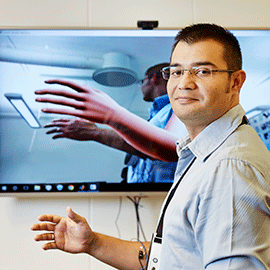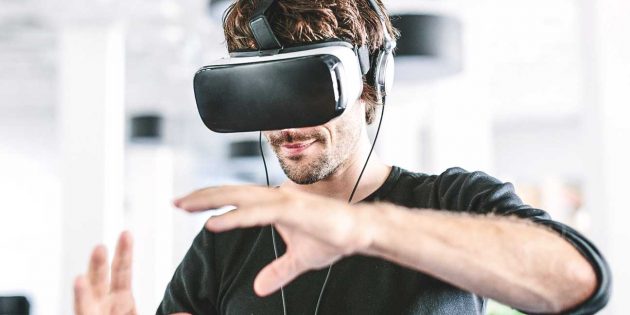People who lose an arm or leg often experience phantom limb pain, as if the missing limb was still there. Phantom limb pain can become a serious chronic condition that significantly reduces the patients’ quality of life. It is still unclear why phantom limb pain and other phantom sensations occur.
Several medical and non-medical treatments have been proposed to alleviate phantom limb pain. Examples include mirror therapy, various types of medications, acupuncture, and implantable nerve stimulators. However, in many cases nothing helped.
Experts say a new, technology-based method of treating phantom pain shows promise, but using it on a widespread basis could be challenging.
Imagining you are somewhere else might help you eliminate phantom pain. Researchers at Chalmers University of Technology in Sweden have reported promising results in using computer reality technology to treat phantom pain in people with amputated limbs.
The team, led by Max Ortiz Catalan, Ph.D., says that using augmented reality – a form of virtual reality – can significantly reduce the pain that many people experience in lost limbs.
Phantom pain occurs when a person loses a limb, causing chronic pain in the remaining portion of the arm or leg.It can be difficult to adequately treat, but this recent research suggests that advances in technology could be a breakthrough.
Ortiz Catalan’s team looked at 14 people with amputated arms who were experiencing phantom pain.
“We selected the most difficult cases from several clinics,” Ortiz Catalan said in a press release. “We wanted to focus on patients with chronic phantom limb pain who had not responded to any treatments. Four of the patients were constantly medicated, and the others were not receiving any treatment at all because nothing they tried had helped them. They had been experiencing phantom limb pain for an average of 10 years.”
At the end of the 12th, and final, session of treatment, researchers noted that the intensity, frequency, and quality of phantom pain had decreased by about 50 percent. The researchers recently published their findings in The Lancet.
Traditional treatments can fall short
Phantom pain is not a new phenomenon, but there is no foolproof method for treating the condition. Melita Giummarra, Ph.D., a researcher at Monash University in Australia, described some current treatment methods in an email to Healthline.
“Traditional methods included medications for neuropathic pain, stimulation-based techniques, or a range of behavioral/illusion-based interventions,” she wrote. “One of these is mirror therapy, where you position a mirror at the midline of your body, ‘place’ the phantom limb behind the mirror, and observe the real limb moving in the mirror while also moving the phantom limb.”
“Medications frequently have bad side effects, and the stimulation techniques require rental or purchase of equipment, or attendance at medical clinics. So there are barriers,” she noted.
“Mirror therapy is useful for many people as long as they’re able to continue it over time.”
Adding Technology
While augmented reality is a fairly new technology, researchers used some of the knowledge gained from mirror therapy in the development of their new treatment method.
There are similarities between the two, but augmented reality therapy can help when mirror therapy falls short.
“The augmented reality is, in some ways, a fancy version of mirror therapy that significantly enhances the immersion in the illusion,” wrote Giummarra. “Mirror therapy is also limited to unilateral amputees, whereas the latest augmented reality method does not rely on the intact limb for the visual representation of the limb.”
“In mirror therapy, the coupling of the phantom and real limb movement requires effort from the amputee to maintain consistency. It is my understanding, however, that the method developed by Dr. Ortiz Catalan learns the profile of phantom limb movement from muscle contractions in the stump so that the muscle contractions themselves then control movements in the virtual environment without requiring conscious effort,” Giummarra added.
Lots of Work Ahead
 Augmented reality shows promise when it comes to treating phantom pain, but research is still in its infancy. “It is yet to be seen whether this tool can be implemented at a large scale in the home setting,” wrote Giummarra. “I’m sure that this is not really too far off given the accessibility of virtual reality devices, but I wonder whether it will be accessible for the bulk of patients who need it most — those with fewer financial resources or limited mobility.”
Augmented reality shows promise when it comes to treating phantom pain, but research is still in its infancy. “It is yet to be seen whether this tool can be implemented at a large scale in the home setting,” wrote Giummarra. “I’m sure that this is not really too far off given the accessibility of virtual reality devices, but I wonder whether it will be accessible for the bulk of patients who need it most — those with fewer financial resources or limited mobility.”
This technology has become more accessible in recent years. In 2016, Oculus Rift, HTC, Sony, Samsung, LG, and others released virtual reality headsets commercially.
In addition, Ortiz Catalan’s team released two types of technology to use in the treatment – a clinically friendly version along with an open-source version that developers could integrate into commercial headsets.
Ortiz Catalan acknowledges that the initial clinical trials are just a jumping off point, but he expresses optimism for further research.
“Our joint project was incredibly rewarding, and we now intend to go further with a larger controlled clinical trial,” Ortiz Catalan said. “The control group will be treated with one of the current treatment methods for phantom limb pain. This time we will also include leg amputees.”
“More than 30 patients from several different countries will participate and we will offer more treatment sessions to see if we can make the pain go away immediately,” he added.
More about: Advantages of the method
Phantom motor execution has a several advantages over other methods to treat phantom limb pain:
- Creates an environment in which all parts fit together naturally. The patient’s desire to use the amputated limb activates the appropriate part of the brain and creates actual movement signals in the nerves and muscles of the stump, which leads to real-time visual feedback.
- Requires no surgical intervention and has no known side effects at present.
- Can be used even if both arms (or both legs) are amputated.
- Allows recreation of most movements that a natural arm (or leg) can make.
- Creates motivation using a computer game and precise measurements of the patient’s progress.
- Has a low cost compared to invasive treatment methods used today.
Thus, the perceived phantom arm is brought to life by a virtual representation that the patient can see and control. This allows the patient to reactivate areas of the brain that were used to move the arm before it was amputated, which might be the reason that the phantom limb pain decrease. No other existing treatment for phantom limb pain generates such a reactivation of these areas of the brain with certainty. The research led by Ortiz Catalan not only creates new opportunities for clinical treatment, but it also contributes to our understanding of what happens in the brain when phantom pain occurs.
The technology for phantom motor execution is available in two modalities – an open source research platform, and a clinically friendly version in the process of being commercialised by the Gothenburg-based company Integrum.
The researchers believe that this technology could also be used for other patient groups who need to rehabilitate their movement capability, for example after a stroke, nerve damage or hand injury.





